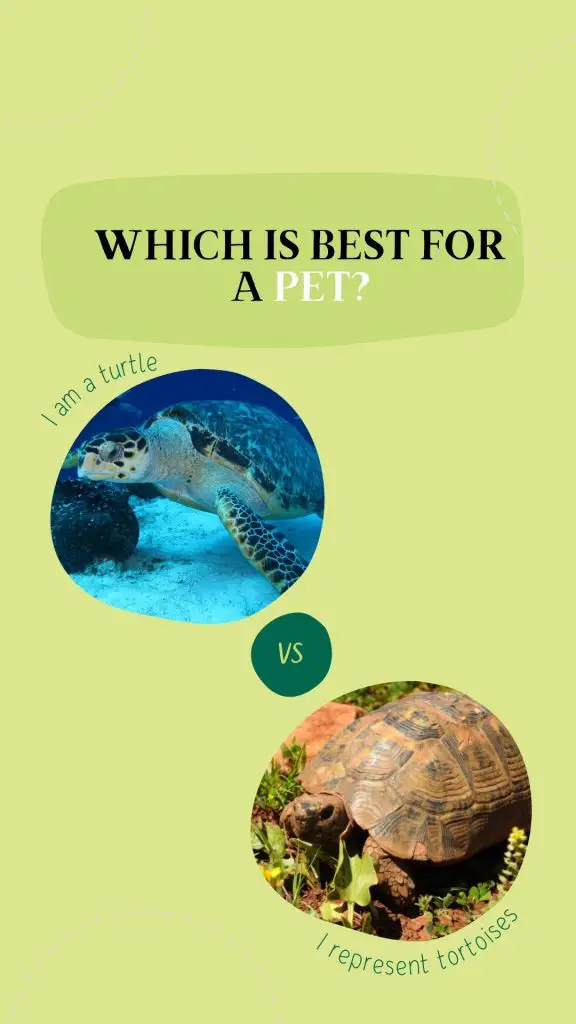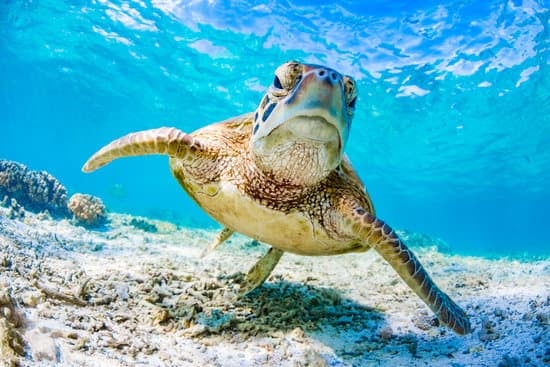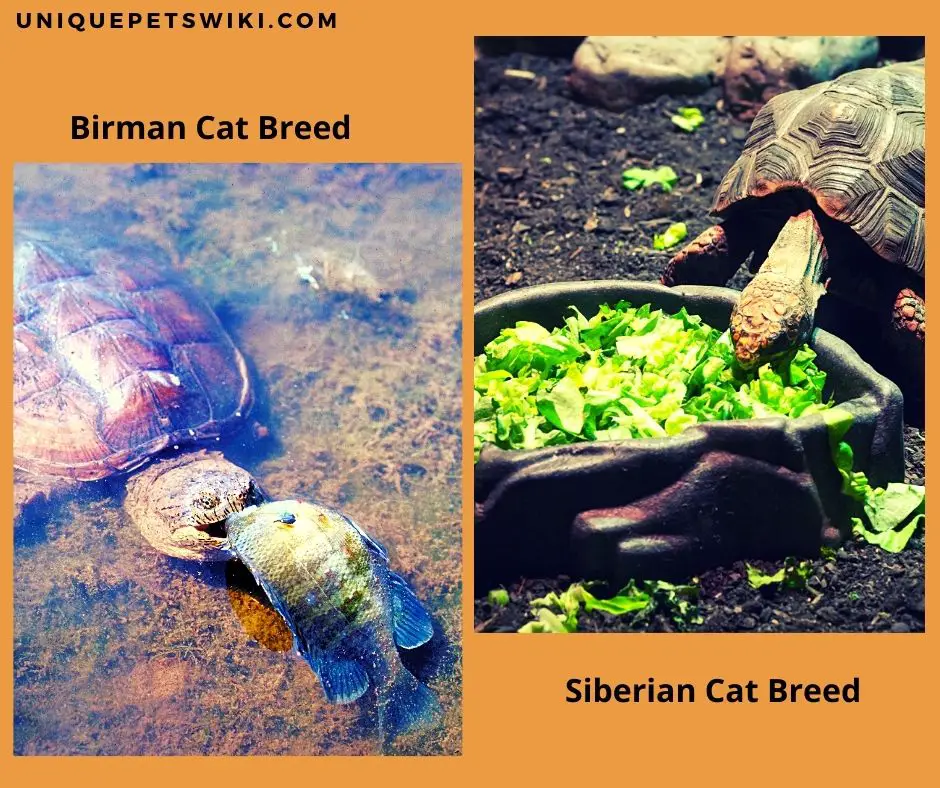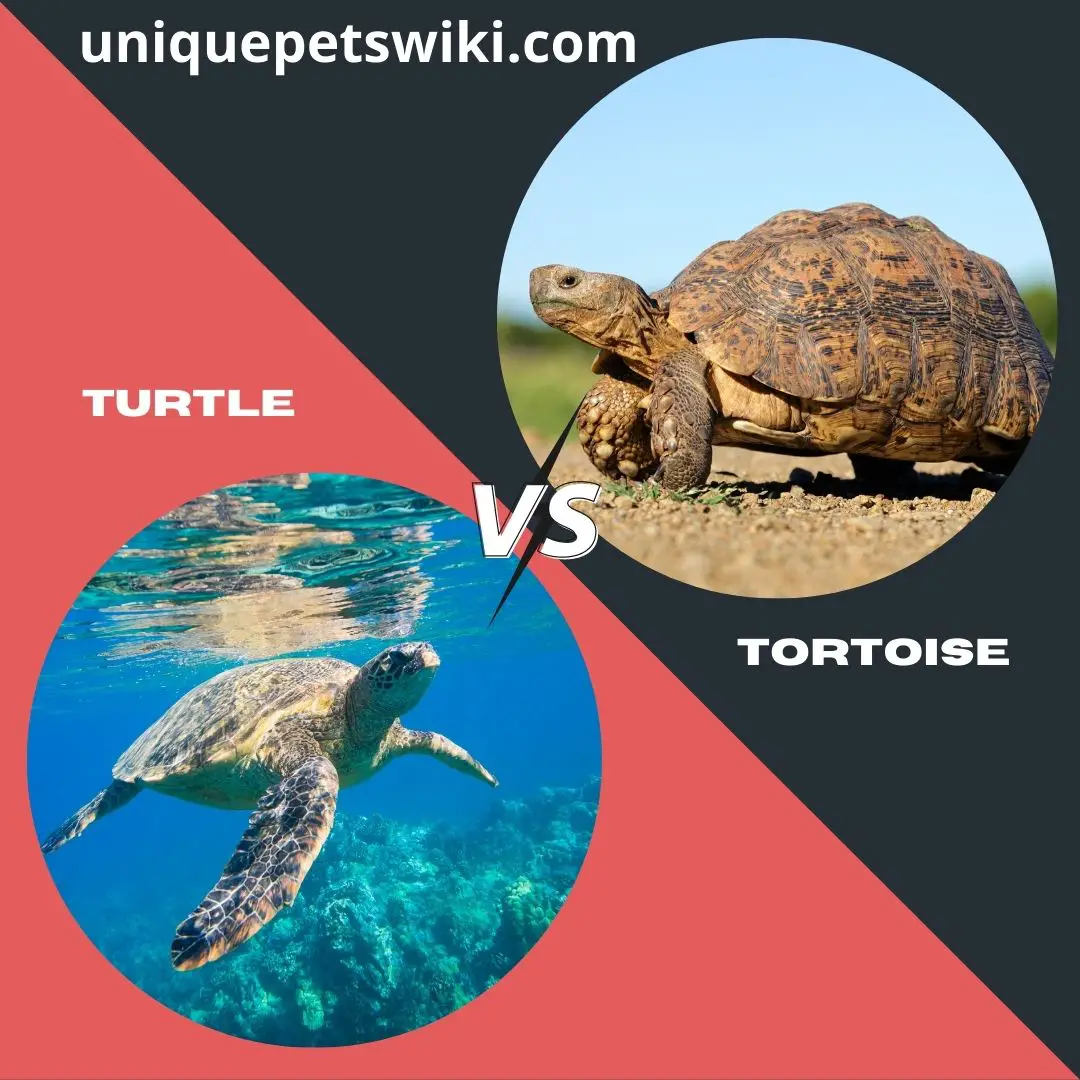It’s easy to confuse a turtle with a tortoise and vice versa since they are visually alike. These two reptiles share a typical order called Testudines and are shielded by a shell.
Ever heard the saying that goes, “All tortoises are turtles, but not all turtles are tortoises?” What do you think? It’s not a mistaken statement but complete honesty.
If you delve deeper into these two reptiles, you will know that they’re different, and each species has its specific requirements as pets.
Want to know how turtles and tortoises differ from each other? You didn’t get lost; this is the place to find your answers.
The article also explains the similarities between these two species and their needs as pets. Read on for more!
Contents
Turtle Vs Tortoise: Full comparison
With the similarities and differences of turtle and tortoise in mind, you can choose the pet that you want without complications.
That means that you have to know their geographical and behavioral differences, plus maintenance costs for each.
For simplicity, we will explore the characteristics/information for each type, including lifespan, growth rate, habitat, diet, required take care, brumation, costs, etc.
By the end of this comparison, you should be able to tell a turtle and a tortoise apart. Let’s get started!
Appearance
Turtles and tortoises are closely related reptiles and therefore have a couple of physical features in common. Both have a hard beak, and their bodies are encased in a bony shell with scutes.
Generally, tortoises can become much larger and heavier than turtles. They are cold-blooded reptiles, hence depend on external temperatures to control their body processes.
Moreover, the shell, feet, and leg shapes for turtles and tortoises are dissimilar. Let’s see how!

Shell Shape
Turtles have relatively flat, thin, and streamlined shells. They dwell much in the water, so the shell is adapted to help them swim and dive effectively.
However, box turtles and some mud turtles are exempted from the list. Their shells are otherwise dome-shaped.
Conversely, a tortoise possesses a heavier, rounded, and dome-shaped shell. These species are land dwellers, making their shells convenient in protecting them from predators.

Verdict: The shell shape of turtles and tortoises adapts to their habitat. The turtle’s shell is lighter to avoid sinking and enhances swimming speed, and tortoises have a large, dome-shaped, and heavy cover that offers protection from predators.
Feet and Leg Shapes
You can distinguish a turtle from a tortoise by checking its feet and leg shapes. Turtles have webbed feet with long claws that give a good grip onto floating objects and assist in climbing in and out of water.
Some turtles have true flippers instead of feet. Again, box turtles are an exception since they lack webbed feet and flippers.
Tortoises have short, padded, and well-built feet. The feet have horned and scaly toes that slightly resemble a young elephant’s feet.

Likewise, the legs of these reptiles are bent and directly under their body. The tortoises’ chunky legs help them to carry their weighty body around on land.
Verdict: The turtle and tortoises’ feet and legs are significantly different because the two creatures have diverse habitats.
Habitat
Another significant difference between the two species is where they live. Turtles live primarily in water, but they come to land for different purposes, e.g., laying eggs, basking, or even hibernating.
You can find turtles in ponds, rivers, estuaries, wetlands, oceans (sea turtles), lakes, streams, lagoons, and more.
Tortoises inhabit grasslands, semi-arid zones, mountainsides, deserts, scrub forests, and tropical rainforests.
Semi-arid zones contain a lot of tortoise species. These reptile pets perform well in outdoor pens.
Verdict: Most species of turtles are aquatic, but a few, like box turtles, need water only for hydration and spend much time on dry land. Tortoises are purely land dwellers.
Growth Rate and Lifespan
Turtles grow at a rate of 0.2-1.0 cm/yr, depending on age. The hatchlings grow pretty fast. Turtles tend to live longer than most pets. Their average lifespan is 20-50+ years, with the oldest in history being 86 years.
On the other hand, healthy tortoises can grow to 2-5 cm in one year. They are renowned for living longer.
The tortoise’s average life expectancy is 80-100+ years. The longest living tortoise is said to be 188 years.
Verdict: Tortoises’ lifespan surpasses that of human beings, living over 100 years. Turtles, too, have an increased lifespan. However, how long both species live depends on species, diet, and environment.
Predators
Animals like opossums, skunks, raccoons, coyotes, ferrets, and weasels will kill and eat turtles if given the opportunity.
The hatchlings and young juvenile turtles are more disadvantaged when it comes to predators. They have many natural threats, including dogs, wild pigs, raccoons, sharks, dolphins, snappers, barracuda, etc.
Many animals prey on tortoises. The juvenile and tortoise eggs are natural foods to ground squirrels, Gila monsters, skunks, badgers, roadrunners, snakes, and ravens.
Adult tortoises are also not safe. Coyotes, kit foxes, skunks, bobcats, golden eagles, and badgers typically attack and eat adult tortoises.
Verdict: Both turtles and tortoises have many natural predators. Turtles have threats from land and in water.
Active level
Turtles are highly active during the day, and they are busy swimming, hiding, basking, and diving. The night is their resting time, but they only sleep for 4-6 hours, and their energy is resumed again.
Subsequently, turtles spend a reasonable time of their night doing the same activities they will do during the day, only that the night activities are minor and noiseless.
Tortoises are diurnal and crepuscular chelonians. During the day, primary tortoise activities range from foraging, eating, and mating. However, at night they are hiding in burrows and vegetation.
Tortoises usually sleep for 10-12 hours, and when they’re awake, the babies can go for 19-22 hours.
Verdict: Turtles and tortoises are very active during the day and sleep at night. They are diurnal reptiles.
Swimming/Run Ability and Speed
The turtle’s webbed feet/flippers, sleek and streamlined shells are designed for aquatic life. They are extravagant swimmers, and the majority can swim at a speed of 2.8-10 km/h.
However, leatherback sea turtles are jet; they can swim as fast as 35km/h. Tortoises can’t swim and will only visit a water source when drinking water or bathing.
They have a heavy body, plus their domed shell cannot allow them to swim. Also, tortoises are not fast runners but can walk a bit faster than usual at certain times.
The fastest tortoise in records is the leopard tortoise that has been verified to walk for 1km/h. These species are poor jumpers too.

Personality And Defense Mechanisms
Turtles have a personality too, and it’s typically characterized by aggressiveness and curiosity. Many of these species withdraw into their shells when under threat, but others are brave enough to fight back, usually biting.
Most turtles can be overly aggressive, but it’s recommended to choose a less aggressive species before bringing it home.
Contrastingly, tortoises are cool, gentle, and affectionate animals. They don’t only accept affection but give it too. You can freely interact with a pet tortoise and enjoy its company.
However, tortoises can be overly aggressive, too, especially in the presence of danger or members of the same sex. Tortoises typically hide from danger.
Verdict: Tortoises are more fun to be around with compared to the pretty aggressive turtles.
Diet
Turtles eat both meat and plants. Their diet consists of snails, slugs, crickets, tomatoes, worms, salamanders, cooked meat, de-clawed crayfish, dandelion leaves, apples, etc.
Pet stores also have turtle pellets that are good for supplementing your turtle pet to keep it healthy.
Tortoises are primarily vegetarians, but they can also eat a little bit of meat. They do well with leafy green vegetables, e.g., kales, collard greens, dandelion leaves, mustard greens, etc.
Melon, berries, and oranges are also good fruits to feed tortoises, although in limited proportions. Ideally, fruits should not make more than 5-10% of the tortoise diet.
Verdict: Turtles are simply omnivores, while tortoises eat a plant heavy-diet and a minimal amount of meat.
Shedding
Turtles periodically shed the skin of their shells or scutes. Shedding is necessary to allow the shell to expand as the body continues to grow. However, when it’s shed in excess it’s an issue to be concerned.
A turtle that is shedding appears like it has a thin, tissue-like fiber peeling from the body. Turtles shed as infrequently as 1-2 times per year, but some turtles often shed about every two months.
Tortoises shed their skin and shell every few months to allow room for growth. Their old skin falls off in pieces from the head, limbs, and tails.
Tortoises can’t shed the skin in one large piece and take it off as many reptiles do. Shedding is a requirement for growth.
Verdict: Both turtles and tortoises peel their skin bit-by-bit until shedding is complete. They shed to regenerate and rejuvenate themselves.
Brumation
Turtles go into a period of dormancy during the cold months. Only some species of turtles brumate, including snapping turtles, wood turtles, box turtles, red-eared sliders, and spotted turtles.
The length of brumation for turtles varies depending on where they live, but the majority brumate for 2-4 months.
Hermann’s tortoises, Russian tortoises, Gopher tortoises, Texas tortoises, Marginated tortoises, and Spur-thighed tortoises are all brumating tortoises. Brumation lasts for about 2-4 months.
Verdict: Both turtles and tortoises are known to brumate, and this technique helps them preserve energy in extreme cold months.
Mating
Mating in turtles takes place from spring through autumn. Courtship ritual is characterized by a male following the female, and both meet face-to-face. Subsequently, the male vibrates its front claws around the female’s head to woo her.
The mating season for a tortoise is during spring and summer. The male circles the female while nodding his head and biting the edges of the female’s carapace and her legs. Both genders are aggressive, but females submit eventually.
Verdict: Turtles and tortoises primarily mate during summer and winter. Mating is not easy for both species.
Reproduction
A female turtle lays around 3-200 eggs per nest. The average incubation period of turtles ranges between 60-90 days, and hatchlings spend 90-120 days alone in their nest.
Tortoises lay around 2-12 eggs per nest and hide them in burrows where hatching happens after 8-11 weeks.
Verdict: Turtles have no business with their eggs after laying, but tortoises usually protect the nest during incubation and a couple of weeks after hatching.
Required Take Care
Taming turtles and tortoises is rewarding and interesting, but you should consider providing all the essentials as required.
Enclosure Size
The enclosure size for turtles varies depending on the species and size of turtles. A tank size of 80-gallon is okay for one turtle. Ideally, go for a tank that is 10-gallon for every inch of your pet turtle’s shell length.
A single adult tortoise will need a 75-gallon tank to ensure adequate space. A medium-size complete change of water, but some species are fine in a 20-gallon enclosure.
Lighting, Heating, Humidity Requirements
Turtles need high-quality UV light. 10% UVB bulbs are a good choice for them. The water temps should be 78℉ and land temps between 80-85℉. The relative humidity for most turtles is typically about 80%.
UVB lamps producing 10-12% UVB lights are perfect for tortoises. The temps vary considerably, with the warm side reading 95-105℉ and cool side 75-85℉ at daytime. The night temperatures are around 65-75℉.
Relative humidity of 50-60% should be okay with tortoises, as long as there’s a humid and dry area for them.
Verdict: Turtles and tortoises are cheap to maintain, but tortoises may be a bit expensive if you have a larger species.
Suitability: Best for Whom?
Turtles are somehow aggressive and require you to live carefully with them. Beginners can keep them, but an experienced person will be better positioned to take care of them.
Tortoises are friendly and affectionate, plus they’re low-maintenance pets, and therefore, suitable for beginners.
Verdict: Tortoises are more people-friendly than turtles. Moreover, a tortoise doesn’t need a bunch of water in its enclosure and therefore requires less care than turtles.
Costs
The upfront cost of acquiring a turtle is typically between $20-$2000 or more, depending on the turtle’s species and age. The monthly food budget should be around $30 if you stick to feeding packed commercial diets.
The cost of buying a tortoise ranges between $50-$2500, depending on species, age, breed, and the seller. Expect to spend $30 or less on the food budget per month.
Verdict: The initial average cost of owning a turtle while considering all the essentials and the price of a turtle is more expensive than the initial average cost of obtaining a tortoise.
Ability To Keep in Groups
Turtles do not need a friend companion. They are territorial, aggressive, and like staying alone. But some species can tolerate each other, and if that’s the case, they need a larger space.
Tortoises are solitary reptiles too. The majority of the species appreciate living alone, but others relate well with their cage mates. You can house one male vs. two females but never let males stay together.
Verdict: The ability to keep in groups among tortoises and turtles depends on which species you are dealing with.
Common Types of Turtles
The name turtle carries a lot of species with distinctive characteristics and appearances. Check the list below for the different types of turtles.
- Eastern box turtles,
- Mississippi map turtles,
- Common musk turtles,
- African side-neck turtles,
- Red-eared sliders,
- Western painted turtles,
- Yellow-bellied sliders,
- Spotted turtles,
- Reeve’s turtles,
- Wood turtles, etc.
Common Types of Tortoises
There are a wide variety of tortoise species commonly kept as pets. Some species make great pets than others.
Below are some species of common turtles.
- Russian tortoise,
- Marginated tortoise,
- Egyptian tortoise,
- Leopard tortoise,
- Sulcata tortoise,
- Pancake tortoise,
- Greek tortoise,
- Indian star tortoise, etc.
Wrapping Up
Tortoises do not need much attention and are usually easier to care for, but owning them is expensive.
Turtles and tortoises have a long lifespan compared to many pets and require a person ready to keep a pretty long commitment.
The choice to keep either a turtle or tortoise will depend on a person’s preference. Despite being related reptiles, turtles and tortoises have differences in their take care level, personality, habitat requirements, costs, etc.
